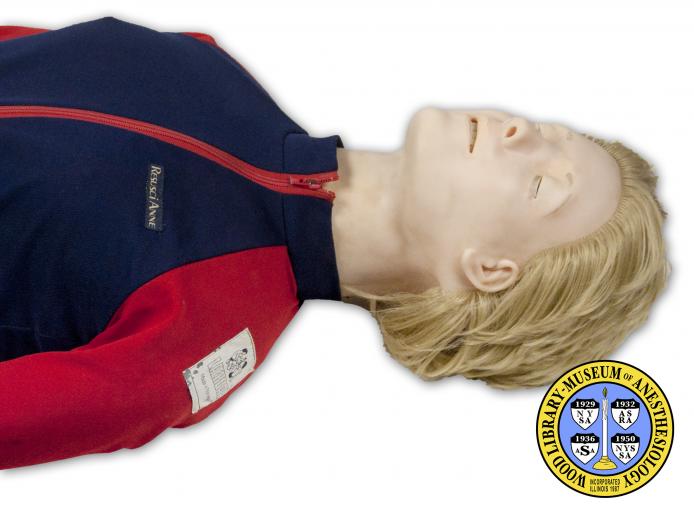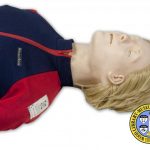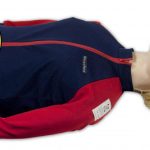Resusci-Anne
If a patient needs resuscitation during surgery, this is one of the anesthesiologist's responsibilities. Two anesthesiologists, Dr. James Elam (1918-1995) and Dr. Peter Safar (1924-2003) each published research in 1958 that showed the superiority of mouth-to-mouth resuscitation (or "rescue breathing") over other methods. Impressed by their ideas, Laerdal Medical Ltd. developed a plastic manikin to teach the mouth-to-mouth technique. At Dr. Safar's suggestion, Laerdal added another simulation function to teach chest compressions (cardio-pulmonary resuscitation, or CPR). Introduced in 1960, the Resusci-Anne was the first lifelike manikin designed to teach both of these lifesaving techniques.
Catalog Record: Resusci-Anne
Access Key: aiqb
Accession No.: 2006-09-04-1
Title: Resusci Anne / [designed by Asmund Laerdal].
Author: Laerdal, Asmund S.
Corporate Author: Laerdal.
Title variation: Alt Title
Title: Resusci-Anne.
Title variation: Alt Title
Title: Laerdal’s Resusci-Anne manikin.
Title variation: Alt Title
Title: Resusci Annie.
Title variation: Alt Title
Title: Resusci Anne complete.
Publisher: Norway : Laerdal ; Armonk, N.Y.: Laerdal Medical Corp. [distributers,
1982-2000].
Physical Description: 1 simulation model : plastic, rubber, medals, fabric ; 150 x 52 x 23 cm.
Subject: Simulation.
Subject: Cardiopulmonary Resuscitation – education.
Subject: Manikins.
Subject: Safar, Peter J., 1924-2003.
Note Type: General
Notes: Title from manufacturer markings on clothing.
Note Type: With
Notes: With a blue carrying and storage case approx. 29 x 92 x 52 cm. Some rusting
on the hinges. Basic instructions on paper are pasted to the inside of the
lid, they include a ‘1-800’ number for service information and the New York
address.
Note Type: Citation
Notes: Grenvik A, Schaefer J. From Resusci-Anne to Sim-Man: the evolution of
simulators in medicine. Crit Care Med. 2004;32(2)(suppl):s56-s57.
Note Type: Citation
Notes: Lind B. The birth of the resuscitation mannequin, Resusci Anne, and the
teaching of mouth-to-mouth ventilation. Acta Anaesthesiol Scand.
2007;51(8):1051-1053.
Note Type: Citation
Notes: Safar P. Manual versus mouth-to-mouth methods of artificial respiration.
Anesthesiology. Jan-Feb, 1958;19(1):111-112.
Note Type: Citation
Notes: Safar P. Ventilatory efficacy of mouth-to-mouth artificial respiration:
airway obstruction during manual and mouth-to-mouth artificial respiration.
JAMA. May 17, 1958;167(3):335-341.
Note Type: Citation
Notes: Safar P, Escarraga L, Elam J. A comparison of the mouth-to-mouth and
mouth-to-airway methods of artificial respiration with the chest-pressure
arm-lift methods. N Engl J Med. April 3, 1958;258(14):671-677.
Note Type: Physical Description
Notes: A full-body manikin (head, torso, arms and legs) simulator for
cardiopulmonary resuscitation (CPR) training; The manikin is female, and has
soft legs of foam filled navy-blue fabric, and white, molded-plastic
tennis-shoes; She has a removable blue and red exercise-jacket (at the time
of this writing, the zipper is stuck in the up-position); Manufacturer
markings are on the front of the jacket on the upper-left side: “RESUSCI
ANNE”; The upper-right arm is marked with, “LAERDAL [new line] MADE IN
NORWAY”; The torso has a removable front shell to allow for the replacement
of the ‘lungs’; The torso includes anatomical markings and characteristics to
facilitate the practice of chest compressions and abdominal thrusts; Two
connection plugs, for a signal box, exit the right side of the torso (if this
manikin previously had an accompanying signal box it is now without one) and
an opening in the right side of the jacket ; A long tube with a rubber bulb
at the end exits the manikin at the back of the head and allows for the
simulation of a carotid-pulse; A head tilt/chin lift and/or jaw thrust is
required to open the airway; The face is soft rubber with a compressible nose
and raisable eyelids; The teeth ar rigid; ; The eyes are viewable, with blue
irises, a left pupil dilated at 10 mm, and a right pupil at 4 or 5 mm; The
hair is synthetic, short and blond.
Note Type: Reproduction
Notes: Photographed by Mr. William Lyle, July 28, 2010.
Note Type: Historical
Notes: “Resusci Anne” was the first simulation manikin designed to teach modern
cardiopulmonary resuscitation (CPR). Since the early 1960s, countless
health-care and lay providers have learned CPR via realistic experiences
using “Resusci Anne” or similar simulation models. In 1958, Dr. Peter Safar
and Dr. James Elam published research that demonstrated the superior
effectiveness of mouth-to-mouth ventilation over the then standard arm
lift-chest pressure ventilation (Safar, Anesthesiology, 1958 ; Safar,
Escarraga & Elam, 1858 ; Safar, JAMA, 1958). Later that year Dr. Safar
presented the research to attendees of a Scandinavian Society of
Anaesthesiologists meeting in Norway, where Dr. Bjorn Lind first learned of
the mouth-to-mouth method for respiratory ventilation. Lind soon began
teaching the new method to colleagues, but was limited due to the lack of
agreeable means for demonstration and practice (Lind, 2007). One idea for an
‘agreeable means’ came from Asmund Laerdal, a Norwegian manufacturer who was
a Red Cross member with a personal interest in first-aid. Laerdal contacted
Dr. Lind via a mutual associate to discuss Laerdal’s conception of a
full-sized manikin designed to realistically simulate the experience of
providing mouth-to-mouth respirations (Lind, 2007). After the manikin was
tested in Norway, Laerdal visited Peter Safar and others in the US to
demonstrate the new educational tool. Predicting the potential for improved
resuscitation from newly published research, Dr. Safar encouraged the
designer to add another simulation function, specifically chest-compressions
(Grenvik & Schaefer, 2004 ; Lind, 2007). Commercial versions of Laerdal’s
simulation model were first introduced in 1960.
Note Type: Publication
Notes: Baskett PJF. Peter J. Safar, the early years 1924-1961, the birth of CPR.
Resuscitation. 2001;50(1):17-22.
Note Type: Publication
Notes: Cooper JB, Taqueti VR. A brief history of the development of mannequin
simulators for clinical education and training. Qual Saf Health Care.
2004;13(suppl 1):i11-i18.



